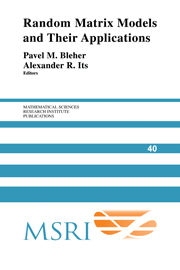Book contents
- Frontmatter
- Contents
- Preface
- Symmetrized Random Permutations
- Hankel Determinants as Fredholm Determinants
- Universality and Scaling of Zeros on Symplectic Manifolds
- z-Measures on Partitions, Robinson-Schensted-Knuth Correspondence, and β = 2 Random Matrix Ensembles
- Phase Transitions and Random Matrices
- Matrix Model Combinatorics: Applications to Folding and Coloring
- Interrelationships Between Orthogonal, Unitary and Symplectic Matrix Ensembles
- Dual Isomonodromic Tau Functions and Determinants of Integrable Fredholm Operators
- Functional Equations and Electrostatic Models for Orthogonal Polynomials
- Random Words, Toeplitz Determinants, and Integrable Systems I
- Random Permutations and the Discrete Bessel Kernel
- Solvable Matrix Models
- The τ-Function for Analytic Curves
- Integration over Angular Variables for Two Coupled Matrices
- Integrable Lattices: Random Matrices and Random Permutations
- SL(2) and z-Measures
- Some Matrix Integrals Related to Knots and Links
Some Matrix Integrals Related to Knots and Links
Published online by Cambridge University Press: 25 June 2025
- Frontmatter
- Contents
- Preface
- Symmetrized Random Permutations
- Hankel Determinants as Fredholm Determinants
- Universality and Scaling of Zeros on Symplectic Manifolds
- z-Measures on Partitions, Robinson-Schensted-Knuth Correspondence, and β = 2 Random Matrix Ensembles
- Phase Transitions and Random Matrices
- Matrix Model Combinatorics: Applications to Folding and Coloring
- Interrelationships Between Orthogonal, Unitary and Symplectic Matrix Ensembles
- Dual Isomonodromic Tau Functions and Determinants of Integrable Fredholm Operators
- Functional Equations and Electrostatic Models for Orthogonal Polynomials
- Random Words, Toeplitz Determinants, and Integrable Systems I
- Random Permutations and the Discrete Bessel Kernel
- Solvable Matrix Models
- The τ-Function for Analytic Curves
- Integration over Angular Variables for Two Coupled Matrices
- Integrable Lattices: Random Matrices and Random Permutations
- SL(2) and z-Measures
- Some Matrix Integrals Related to Knots and Links
Summary
The study of a certain class of matrix integrals can be motivated by their interpretation as counting objects of knot theory such as alternating prime links, tangles or knots. The simplest such model is studied in detail and allows to rederive recent results of Sundberg and Thistlethwaite. The second nontrivial example turns out to be essentially the socalled ABAB model, though in this case the analysis has not yet been carried out completely. Further generalizations are discussed. This is a review of work done (in part) in collaboration with J.-B. Zuber.
1. Introduction
Using random matrices to count combinatorial objects is not a new idea. It stems from the pioneering work [Brezin et al. 1978], which showed how the perturbative expansion of a simple nongaussian matrix integral led, using standard Feynman diagram techniques, to the counting of discretized surfaces. It has resulted in many applications: from the physical side, it allowed to define a discretized version of 2D quantum gravity [Di Francesco et al. 1995] and to study various statistical models on random lattices [Kazakov 1986; Rostov 1989; Gaudin and Rostov 1989; Rostov and Staudacher 1992]. From the mathematical side, let us cite the Rontsevitch integral [Rontsevich 1991; Witten 1991; Itzykson and Zuber 1992], and the counting of meanders and foldings [Makeenko 1996; Di Francesco et al. 1997; 1998].
Here we shall try to apply this idea to the field of knot theory. Our basic aim will be to count knots or related objects. The next section defines these objects, and is followed by a brief overview of matrix models and how they can be related to knots.
Information
- Type
- Chapter
- Information
- Random Matrix Models and their Applications , pp. 421 - 438Publisher: Cambridge University PressPrint publication year: 2001
